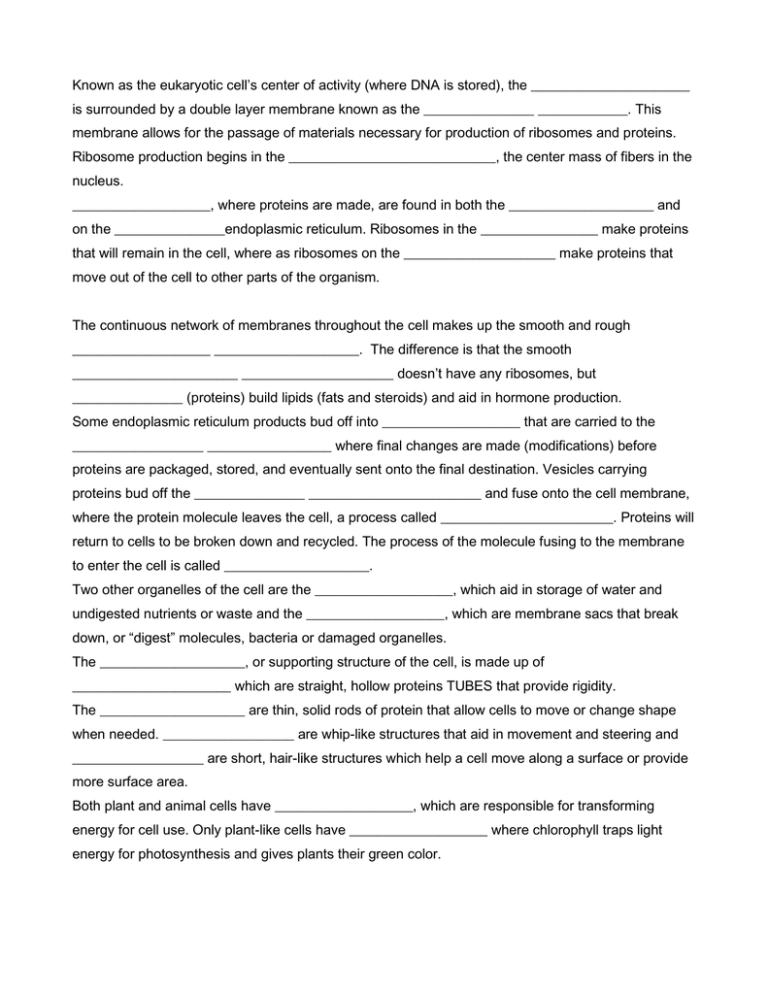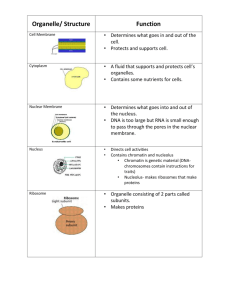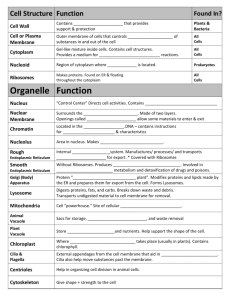Like the farmer man in the dell. The nucleus controls the cell. its
advertisement

Known as the eukaryotic cell’s center of activity (where DNA is stored), the _______________________ is surrounded by a double layer membrane known as the ________________ _____________. This membrane allows for the passage of materials necessary for production of ribosomes and proteins. Ribosome production begins in the ______________________________, the center mass of fibers in the nucleus. ____________________, where proteins are made, are found in both the _____________________ and on the ________________endoplasmic reticulum. Ribosomes in the _________________ make proteins that will remain in the cell, where as ribosomes on the ______________________ make proteins that move out of the cell to other parts of the organism. The continuous network of membranes throughout the cell makes up the smooth and rough ____________________ _____________________. The difference is that the smooth ________________________ ______________________ doesn’t have any ribosomes, but ________________ (proteins) build lipids (fats and steroids) and aid in hormone production. Some endoplasmic reticulum products bud off into ____________________ that are carried to the ___________________ __________________ where final changes are made (modifications) before proteins are packaged, stored, and eventually sent onto the final destination. Vesicles carrying proteins bud off the ________________ _________________________ and fuse onto the cell membrane, where the protein molecule leaves the cell, a process called _________________________. Proteins will return to cells to be broken down and recycled. The process of the molecule fusing to the membrane to enter the cell is called _____________________. Two other organelles of the cell are the ____________________, which aid in storage of water and undigested nutrients or waste and the ____________________, which are membrane sacs that break down, or “digest” molecules, bacteria or damaged organelles. The _____________________, or supporting structure of the cell, is made up of _______________________ which are straight, hollow proteins TUBES that provide rigidity. The _____________________ are thin, solid rods of protein that allow cells to move or change shape when needed. ___________________ are whip-like structures that aid in movement and steering and ___________________ are short, hair-like structures which help a cell move along a surface or provide more surface area. Both plant and animal cells have ____________________, which are responsible for transforming energy for cell use. Only plant-like cells have ____________________ where chlorophyll traps light energy for photosynthesis and gives plants their green color. Cell Theory Rap Listen close to the story I tell. It's the rapping story of the living cell. It's a happy tune that's sort of cheery. About a real tough topic called the cell theory. All animals, plants, and protists too, Are made of cells with different jobs to do. They're the basic units of all organisms, And I hope by now you got the rhythm. It all started with one dude named Hooke. Who at some cork cells took a look. He used a scope and took his time. 'Cause a cell is small and thinner than a dime. Now please don't lose your science enthusiasm, Listen to the story of the cytoplsm. All around the cell this thick fluid does go, But in the nucleus it will not flow. And don't forget those ribosomes This is where proteins come from. These protein factories are so small, you'll agree, You need an electron microscope to see. Just when you thought you weren't having any fun, Along comes teh endoplasmic reticulum. These tubelike structures serve as a track, To carry stuff to the membrane and back. Say 1, 2, 3, 4, Are you ready to learn some more? The animal cell has many parts, And you must know each one by heart. Now have you ever seen any doughnuts without holes? In a cell, they're called vacuoles. They're filled with stuff like H2O And they carry food so the cell can grow. Like the farmer man in the dell. The nucleus controls the cell. its gives the orders -- kind of like a brain. And it's protected by a nuclear membrane. Las of all, but not the very least, Mitochondria - mighty cellular beasts, Since they turn sugars into energy so well, We call them the powerhouse of the cell. Around the cell, you'll find another "skin," The cellular membrane holds the whole cell in But its job isn't simple there's no doubt, It lets some particles go in and out. Now my friend, you know it well, The unforgettable story of the living cell. "Science World" 10-5-90






